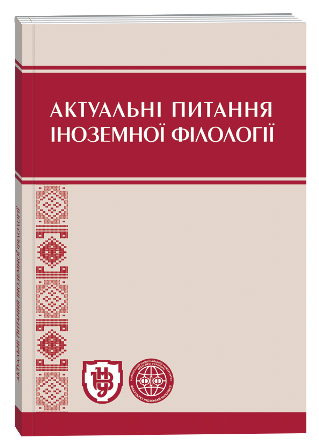ЛЕКСИКО-СТИЛІСТИЧНІ ОСОБЛИВОСТІ ПЕРЕКЛАДУ ХУДОЖНЬОГО ТЕКСТУ НІМЕЦЬКОЮ МОВОЮ (НА МАТЕРІАЛІ ТВОРЧОСТІ СЕРГІЯ ЖАДАНА)
DOI:
https://doi.org/10.32782/2410-0927-2024-20-4Ключові слова:
художній переклад, трансформація, композит, стилістичні засоби, метафора, іронія, порівнянняАнотація
У статті досліджено лексико-стилістичні особливості перекладу художнього тексту німецькою мовою на прикладі роману Сергія Жадана «Інтернат». Розглянуто поняття художній переклад, його особливості та основні вимоги, яких потрібно притримуватися перекладачу під час перекладацького процесу. Установлено, що художній переклад є не лише прямою передачею тексту іноземною мовою, а й також інструментом культурного освоєння світу, чинником певної культури. Проаналізовано авторський стиль та визначено, що письменнику притаманна низка образно-тропеїчних засобів, як-от: епітет, порівняння, метафора, алегорія, символ. Виявлено, що автор звертається до стилістичного прийому іронії та колористики. Використання різних відтінків темних кольорів від чорного до сірого й темно-синього символізує ситуацію розрухи та безпорадності в регіоні, де проживає головний персонаж. Під час порівняння першоджерела і його німецькомовного варіанта зауважено, до яких перекладацьких трансформацій удаються перекладачі. Простежено, що на морфологічному рівні виконавці найчастіше схильні до засобу створення композит, що є типовим для мови перекладу. Найчастіше виникають варіанти «іменник плюс іменник», «прикметник плюс іменник». Задля збереження сенсу чи уточнення конотації певних мовних одиниць застосовують метод генералізації, трансформації та логізації. На синтаксичному рівні в тексті оригіналу часто трапляються складнопідрядні речення, а також речення, ускладнені дієприкметниковими й дієприслівниковими зворотами. Під час перекладу таких випадків виконавці користуються методом опущення та заміною складного речення простим. У ході дослідження виявлено певні відмінності в перекладі, оскільки структура української й німецької мов відрізняється, неможливо завжди зберегти оригінальні конструкції. Зроблено висновки, що перекладачі, майстерно застосовуючи перекладацькі трансформації, зуміли донести читачеві ідею автора та не порушити естетичної цілісності оригіналу.
Посилання
Бабенко А. О. Поетика прози Сергія Жадана: дис. ... д-ра філос. Київ, 2021. 195 с.
Баклан І. М., Лисенко Г. Л., Чепурна З. В. Основи перекладу – міст між теорією і практикою (німецько-український напрям): підручник. Київ: КПІ ім. Ігоря Сікорського, Вид-во «Політехніка», 2019. 204 с.
Бондарчук О. Ю., Лисецька Н. Г. Концептуальний переклад: до питання трансферу культурно маркованих текстових елементів (німецька та українська мови). Актуальні питання іноземної філології: наук. журн./(редкол.: І. П. Біскуб (голов. ред.) та ін.). Луцьк, 2020. № 13. С. 33–39.
Вегеш А. I. Семантичне навантаження літературно-художніх антропонімів у романі «Інтернат» Сергія Жадана. Науковий вісник Ужгородського університету. 2018. Вип. 2. С. 16–20.
Жадан С. В. Інтернат. Чернівці: Вид. Померанцев С. 2017. 336 с.
Кияк Т. Р., Огуй О. Д., Науменко А. М. Теорія та практика перекладу німецької мови: підруч. для студентів вищ. навч. закл. Вінниця: Нова кн., 2006. 59 с.
Кононенко В. І. Український новостиль: лінгвопоетика художнього дискурсу Сергія Жадана. Науково-теоретичний журнал Інституту українознавства при Прикарпатському національному університеті ім. Василя Стефаника. 2018. Вип. 19. С. 17–31.
Манакін В. М., Росоха О. В. Особливості перекладу власних назв у художній літературі (на матеріалі книги Сергія Жадана «Депеш Мод»). Вісник студентського наукового товариства ДонНУ імені Василя Стуса. 2022. Вип. 14. С. 152–155.
Основні лінгвостилістичні поняття й категорії (словник-довідник філолога): укладач: І. І. Коломієць. Умань: ВПЦ «Візаві», 2015. 203 с.
Zhadan S. Internat Suhrkamp Verlag, 2022. 300 с.







